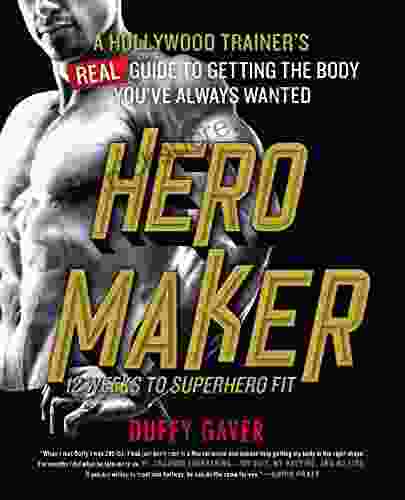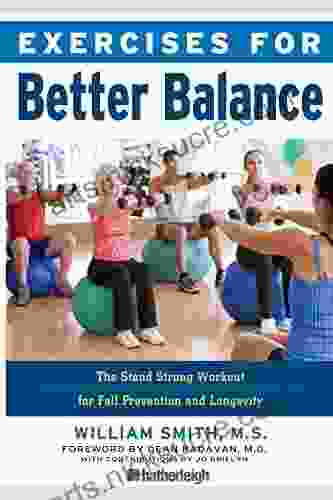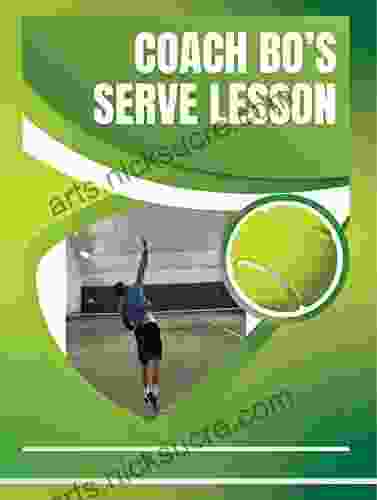Exercises For Better Balance

Balance is an enigmatic term, yet it underlies our every move. It is what keeps us upright, allows us to walk, run, and perform countless other activities without tumbling over. Balance encompasses both physical and cognitive aspects, and its importance cannot be overstated.
While some of us may be naturally gifted with exceptional balance, for others, it can be a lifelong quest. Nevertheless, balance is a skill that can be learned and improved through dedicated practice. In this comprehensive guide, we will explore the multifaceted nature of balance, the factors that influence it, and provide a detailed roadmap of exercises designed to enhance your stability.
4.2 out of 5
| Language | : | English |
| File size | : | 8462 KB |
| Text-to-Speech | : | Enabled |
| Screen Reader | : | Supported |
| Enhanced typesetting | : | Enabled |
| Word Wise | : | Enabled |
| Print length | : | 112 pages |
Understanding Balance
Balance, in essence, is the ability to maintain an upright posture in the face of external forces. It involves three main components:
- Sensory Input: This includes information from our vestibular system (inner ear),proprioception (body awareness),and vision. These systems work in concert to provide us with a comprehensive understanding of our body's position in relation to the environment.
- Motor Control: Once we receive sensory input, our brain coordinates muscle movements to maintain our equilibrium. This is achieved through a complex interplay of muscle contractions and relaxations.
- Integration: The final stage involves integrating sensory input and motor control to produce an appropriate response. This intricate process is modulated by the cerebellum, a brain region responsible for coordinating movement and balance.
Balance: A Delicate Balancing Act
Maintaining balance is a delicate balancing act, and there are numerous factors that can disrupt our equilibrium. These include:
- Inner ear disorders: Conditions such as Meniere's disease and vestibular neuritis can affect the vestibular system, impairing our sense of balance.
- Neurological conditions: Parkinson's disease, multiple sclerosis, and stroke can disrupt the neural pathways involved in balance control.
- Musculoskeletal impairments: Muscle weakness, joint pain, and reduced flexibility can all contribute to balance problems.
- Age-related changes: As we age, our sensory and motor systems decline, making us more susceptible to balance issues.
Unleashing the Power of Exercise: A Path to Enhanced Balance
While balance can be impacted by various factors, it is reassuring to know that targeted exercises can significantly improve our stability. Here is a comprehensive guide to exercises tailored to enhance your balance:
1. Single-Leg Stance:
Description: Stand with your feet hip-width apart. Slowly lift one leg off the ground, bending your knee at 90 degrees. Hold this position for 30 seconds, then switch legs.
Benefits: Strengthens the muscles around your ankle and knee, improving your ability to maintain balance on one leg.
2. Tandem Gait:
Description: Place one foot directly in front of the other, heel-to-toe. Slowly walk forward, taking small steps. Continue for 20 steps, then turn around and walk back.
Benefits: Challenges your balance by requiring precise foot placement and coordination.
3. Heel-Toe Walk:
Description: Start with your feet together. Take a step forward with your right foot, placing your heel in front of your left foot. Then, take a step forward with your left foot, placing your heel in front of your right foot. Continue alternating for 20 steps.
Benefits: Improves coordination and balance by forcing you to focus on foot placement and weight distribution.
4. Side-to-Side Balance:
Description: Stand with your feet shoulder-width apart. Slowly shift your weight to your left foot, lifting your right foot off the ground. Hold for 30 seconds, then shift to your right foot.
Benefits: Strengthens the muscles that control side-to-side movement, enhancing your ability to maintain balance during lateral movements.
5. Clock Reach:
Description: Stand with your feet hip-width apart. Place a cone directly in front of you at 12 o'clock. Slowly reach your right foot to each of the following positions: 3, 6, 9, and 12 o'clock. Repeat with your left foot.
Benefits: Improves dynamic balance and challenges your ability to control your foot placement during multidirectional movements.
6. Balance Board:
Description: Stand on a balance board with your feet shoulder-width apart. Gently rock back and forth, side to side, and in circular motions. Start with small movements and gradually increase the amplitude.
Benefits: Provides a challenging and unstable surface that forces you to engage your core and leg muscles to maintain balance.
Progressive Overload: Key to Continuous Improvement
As with any fitness endeavor, consistency and progressive overload are crucial for continuous improvement. Gradually increase the duration, frequency, and intensity of your balance exercises to challenge your body and promote ongoing progress. Listen to your body and rest when needed, but don't shy away from pushing yourself slightly outside of your comfort zone.
Balance is a fundamental aspect of our well-being, allowing us to navigate our environment with confidence and grace. While various factors can affect our balance, targeted exercises can significantly enhance our stability. By incorporating the exercises outlined in this guide into your fitness routine, you can improve your balance, reduce your risk of falls, and enjoy the myriad benefits that come with enhanced stability.
Remember, improving balance is not a quick fix; it requires dedication and patience. But with consistent effort, you will notice a significant improvement in your ability to maintain equilibrium, empowering you to move through life with greater confidence and poise.
4.2 out of 5
| Language | : | English |
| File size | : | 8462 KB |
| Text-to-Speech | : | Enabled |
| Screen Reader | : | Supported |
| Enhanced typesetting | : | Enabled |
| Word Wise | : | Enabled |
| Print length | : | 112 pages |
Do you want to contribute by writing guest posts on this blog?
Please contact us and send us a resume of previous articles that you have written.
 Fiction
Fiction Non Fiction
Non Fiction Romance
Romance Mystery
Mystery Thriller
Thriller SciFi
SciFi Fantasy
Fantasy Horror
Horror Biography
Biography Selfhelp
Selfhelp Business
Business History
History Classics
Classics Poetry
Poetry Childrens
Childrens Young Adult
Young Adult Educational
Educational Cooking
Cooking Travel
Travel Lifestyle
Lifestyle Spirituality
Spirituality Health
Health Fitness
Fitness Technology
Technology Science
Science Arts
Arts Crafts
Crafts DIY
DIY Gardening
Gardening Petcare
Petcare Alvin E Roth
Alvin E Roth Michael Mcteigue
Michael Mcteigue Jeff Hutton
Jeff Hutton Aditya Chatterjee
Aditya Chatterjee Luca Vargiu
Luca Vargiu Harper Paris
Harper Paris Sam L Savage
Sam L Savage Pete Jordan
Pete Jordan Greg Wyshynski
Greg Wyshynski Fred Luskin
Fred Luskin Duffy Gaver
Duffy Gaver Thich Nhat Hanh
Thich Nhat Hanh Bruce Hood
Bruce Hood Noah Michaud
Noah Michaud Ari Marmell
Ari Marmell Seymour Lipschutz
Seymour Lipschutz Letitia Baldrige
Letitia Baldrige Tommy Caldwell
Tommy Caldwell Mariel Hemingway
Mariel Hemingway Chuck Mckeever
Chuck Mckeever Lori Bregman
Lori Bregman Ursula Goodenough
Ursula Goodenough William Smith
William Smith C K Murray
C K Murray Marissa Anderson
Marissa Anderson Martin Dorey
Martin Dorey George A Morgan
George A Morgan Dagogo Altraide
Dagogo Altraide Alexandra Christo
Alexandra Christo Gregory Curtis
Gregory Curtis Wayne Curtis
Wayne Curtis Adam Stevenson
Adam Stevenson Linus Wilson
Linus Wilson Trevor Rowley
Trevor Rowley Sergei Urban
Sergei Urban Valerie Melvin
Valerie Melvin Haym Kruglak
Haym Kruglak Tony Grice
Tony Grice Helen Xander
Helen Xander Stephen Brennan
Stephen Brennan Johnathon Allen
Johnathon Allen Adrienne Young
Adrienne Young Baby Professor
Baby Professor Myatt Murphy
Myatt Murphy Ahmad Al Sukaini
Ahmad Al Sukaini Scott B Williams
Scott B Williams Frank Delaney
Frank Delaney Bruce Rosenfeld
Bruce Rosenfeld Eric Adelson
Eric Adelson Sam Fadala
Sam Fadala Hannes Wessels
Hannes Wessels Brian K Jones
Brian K Jones Libbi Palmer
Libbi Palmer Cindy Nana Parente
Cindy Nana Parente Nicholas Kardaras
Nicholas Kardaras Adrian Gonzales
Adrian Gonzales Melinda Folse
Melinda Folse Zachery Knowles
Zachery Knowles Renato Rosaldo
Renato Rosaldo Amy Bartelloni
Amy Bartelloni Kathryn Casey
Kathryn Casey Jacqueline Houtman
Jacqueline Houtman Anita Bean
Anita Bean Shelley Metten M S Ph D
Shelley Metten M S Ph D Philip Maffetone
Philip Maffetone Agnieszka Latocha
Agnieszka Latocha Timothy Gowers
Timothy Gowers Adrian Li
Adrian Li E Lockhart
E Lockhart Collins Easy Learning
Collins Easy Learning Doris J Barnes
Doris J Barnes George Sheehan
George Sheehan Sun Yung Shin
Sun Yung Shin Herbert Clyde Lewis
Herbert Clyde Lewis Andrea Ros
Andrea Ros Fergus Connolly
Fergus Connolly Alexi Pappas
Alexi Pappas Jeff Wiltse
Jeff Wiltse Joanna Warrington
Joanna Warrington Adele Jones
Adele Jones Adrian Smith
Adrian Smith Walter Rhein
Walter Rhein Eric Hoffer
Eric Hoffer Warwick Rodwell
Warwick Rodwell Aftab Hamid
Aftab Hamid Jeff Wallach
Jeff Wallach Leigh Bardugo
Leigh Bardugo Jordan Bone
Jordan Bone Lydia Kang
Lydia Kang Stephen Tignor
Stephen Tignor Afsaneh Moradian
Afsaneh Moradian Gary Lonesborough
Gary Lonesborough Brad Rock
Brad Rock James Mcdougall
James Mcdougall Joan Naidorf
Joan Naidorf John North
John North Michael S Weisbach
Michael S Weisbach Team Golfwell
Team Golfwell Alicia Young
Alicia Young Shami Stovall
Shami Stovall Adrian May
Adrian May Tim Hodkinson
Tim Hodkinson Kara Powell
Kara Powell Sherrie Nist Olejnik
Sherrie Nist Olejnik Carol Grbich
Carol Grbich Kim Gosselin
Kim Gosselin Bonnie Raingruber
Bonnie Raingruber Allie Duzett
Allie Duzett Jo Deurbrouck
Jo Deurbrouck Boy Scouts Of America
Boy Scouts Of America Taylor Markarian
Taylor Markarian Tom Ryan
Tom Ryan John Nero
John Nero Robin L Rielly
Robin L Rielly Aubre Tompkins Cnm
Aubre Tompkins Cnm Amy Kovarick
Amy Kovarick Noson S Yanofsky
Noson S Yanofsky Natania Barron
Natania Barron Zainab Yate
Zainab Yate Max Mason
Max Mason Kendare Blake
Kendare Blake Susan Garcia
Susan Garcia Adrian Bejan
Adrian Bejan Max Jammer
Max Jammer Mel Levine
Mel Levine Mike Jacker
Mike Jacker Todd Whitaker
Todd Whitaker Marty Ofonagoro
Marty Ofonagoro James Goi Jr
James Goi Jr Adam Schupak
Adam Schupak Kamala Harris
Kamala Harris Emily Larson
Emily Larson Adam Ploszaj
Adam Ploszaj Alexandra Horowitz
Alexandra Horowitz John Passmore
John Passmore Ken Robinson
Ken Robinson Jacqueline Winspear
Jacqueline Winspear Thomas E Gilson
Thomas E Gilson Christy Isbell
Christy Isbell Malachi Martin
Malachi Martin Karl Sigmund
Karl Sigmund Pearl S Buck
Pearl S Buck Issendai Bechau
Issendai Bechau Dennis Cassinelli
Dennis Cassinelli Charles Dougherty
Charles Dougherty Jose Antonio Fernandez
Jose Antonio Fernandez Brad Borkan
Brad Borkan Larry Clay
Larry Clay Mihaly Csikszentmihalyi
Mihaly Csikszentmihalyi James B Marsh
James B Marsh Kenneth Martz
Kenneth Martz Adams Media
Adams Media Adriana Rabinovich
Adriana Rabinovich Paul Parker
Paul Parker Trisha Yearwood
Trisha Yearwood S Yates
S Yates Kevin Biggar
Kevin Biggar Vedant J Maheshwari
Vedant J Maheshwari Gene Hill
Gene Hill Jennifer Justus
Jennifer Justus Meganne Forbes
Meganne Forbes Bryan Willis
Bryan Willis Maurice Isserman
Maurice Isserman Philip Gardiner
Philip Gardiner George Yule
George Yule Joe Posnanski
Joe Posnanski Joseph A Durlak
Joseph A Durlak Bridget Bishop
Bridget Bishop Steve Mchugh
Steve Mchugh Saidiya V Hartman
Saidiya V Hartman Gianni Filippini
Gianni Filippini Meg Cox
Meg Cox Marta Szabo
Marta Szabo Wendy Heard
Wendy Heard Heather Lende
Heather Lende Paul Weamer
Paul Weamer Shmuel Goldberg
Shmuel Goldberg Master Sajid Ahmed
Master Sajid Ahmed Emily Ross
Emily Ross Sarah Clarkson
Sarah Clarkson Marta Alexander
Marta Alexander Susan Adams
Susan Adams Heidi Dusek
Heidi Dusek Andrea Huneeus Vergara
Andrea Huneeus Vergara Andrew Beyer
Andrew Beyer Jake Schafft
Jake Schafft Mark Bittman
Mark Bittman Adrienne Rawlinson
Adrienne Rawlinson Sarah Stillman
Sarah Stillman Rich Froning
Rich Froning American Alpine Club
American Alpine Club Akilah Hughes
Akilah Hughes John Shelton Reed
John Shelton Reed Zoe Clark Coates
Zoe Clark Coates Michael H Lubetsky
Michael H Lubetsky Adrienne Engleman Pga Fellow Professional
Adrienne Engleman Pga Fellow Professional Timothy D Wilson
Timothy D Wilson Bobbie Ziemer
Bobbie Ziemer Barry Melrose
Barry Melrose Melvin Konner
Melvin Konner Erin Eileen Leigh
Erin Eileen Leigh Agatha Christie
Agatha Christie John D Whidden
John D Whidden Joanne Jamrosz
Joanne Jamrosz Melanie Mitchell
Melanie Mitchell Ademar Aguiar
Ademar Aguiar Julie Gore
Julie Gore Dwayne Bryant
Dwayne Bryant Eric Orton
Eric Orton Dorothy Hamill
Dorothy Hamill Meghan Mccarthy Mcphaul
Meghan Mccarthy Mcphaul Elizabeth Carman
Elizabeth Carman Nelson L Schuman
Nelson L Schuman Natalie Guenther
Natalie Guenther Leslie T Chang
Leslie T Chang Archie Brain
Archie Brain Darron L Clark
Darron L Clark John Muir
John Muir Robin Suerig Holleran
Robin Suerig Holleran Elizabeth Parker
Elizabeth Parker V C Andrews
V C Andrews Marc Roche
Marc Roche J Lynn Bailey
J Lynn Bailey Rod Heckelman
Rod Heckelman Rusty Richards
Rusty Richards Afra J Zomorodian
Afra J Zomorodian Amby Cooper
Amby Cooper Dan Fagin
Dan Fagin M Barlow Pepin
M Barlow Pepin Barbara Mertz
Barbara Mertz Jorge Luis Delgado
Jorge Luis Delgado Frederick J Gravetter
Frederick J Gravetter Phil Cousineau
Phil Cousineau Robert Stone
Robert Stone David A Whitsett
David A Whitsett Jenny Jones
Jenny Jones Spike Walker
Spike Walker Helen Scheuerer
Helen Scheuerer Timothy Malcolm
Timothy Malcolm Elizabeth De Zulueta
Elizabeth De Zulueta Kevin J Cheek
Kevin J Cheek Gerry Lopez
Gerry Lopez Laura Zinn Fromm
Laura Zinn Fromm Ron Elbe
Ron Elbe Adam Pertman
Adam Pertman John Vaillant
John Vaillant Michael D Rich
Michael D Rich James P Lewis
James P Lewis Michael Brooks
Michael Brooks Joe Varady
Joe Varady The Times Mind Games
The Times Mind Games Jane M Healy
Jane M Healy Rebecca Lowe
Rebecca Lowe Peggy Tharpe
Peggy Tharpe Timothy J Baroni
Timothy J Baroni Alvin Boyd Kuhn
Alvin Boyd Kuhn Louisa J Morgan
Louisa J Morgan Dr Paul Lam
Dr Paul Lam Lucy Wolfe
Lucy Wolfe Suzanne Swedo
Suzanne Swedo Rachel Ormston
Rachel Ormston Aenghus Chisholme
Aenghus Chisholme Normandi Ellis
Normandi Ellis Mick Dolan
Mick Dolan Michael Bronski
Michael Bronski Adharanand Finn
Adharanand Finn Adele Faber
Adele Faber Adrian Wilson
Adrian Wilson Alisscia B
Alisscia B Ayelet Fishbach
Ayelet Fishbach Peter Shirley
Peter Shirley Karen J Bun
Karen J Bun Susannah Cahalan
Susannah Cahalan C W Ceram
C W Ceram Richard J Larsen
Richard J Larsen Adam Serwer
Adam Serwer Darrell Huff
Darrell Huff Adam Shaw
Adam Shaw Adrian Wallwork
Adrian Wallwork Carmen Juncal
Carmen Juncal Marie Colvin
Marie Colvin Cynthia A Robertson
Cynthia A Robertson Nancy Mellon
Nancy Mellon Adiba Jaigirdar
Adiba Jaigirdar Mary Ann Drummond
Mary Ann Drummond Harry Pearson
Harry Pearson Avner Ash
Avner Ash Timothy Leffel
Timothy Leffel Elias Johnson
Elias Johnson Dr James Dinicolantonio
Dr James Dinicolantonio Susan Rovezzi Carroll
Susan Rovezzi Carroll Jeff Van West
Jeff Van West Suzy Giordano
Suzy Giordano Amelia Simmons
Amelia Simmons Allen Hedrick
Allen Hedrick David Graeber
David Graeber Paul L Wachtel
Paul L Wachtel Yusra Mardini
Yusra Mardini Afrodite Rossini
Afrodite Rossini Yuu Tanaka
Yuu Tanaka Ilene Skeen
Ilene Skeen Anita Shreve
Anita Shreve Kosol Ouch
Kosol Ouch Ae Marling
Ae Marling Bettina Elias Siegel
Bettina Elias Siegel Jack Heinowitz
Jack Heinowitz Jasmine Taylor
Jasmine Taylor Mark Matlock
Mark Matlock Nicole Bailey
Nicole Bailey Heather Worthington
Heather Worthington Isabella Rotman
Isabella Rotman John D Mccann
John D Mccann Daniel Sobieck
Daniel Sobieck Kathy A Zahler
Kathy A Zahler P Brian Noble
P Brian Noble Alondra Nelson
Alondra Nelson Jd Richey
Jd Richey Robin Jones Gunn
Robin Jones Gunn Matt Morton
Matt Morton James C Dobson
James C Dobson Tim Wise
Tim Wise Lisa Mosconi
Lisa Mosconi George Makari
George Makari Veronica Strang
Veronica Strang Greg Guest
Greg Guest Ed Hanczaryk
Ed Hanczaryk Barry Brown
Barry Brown Kevin Van Whye
Kevin Van Whye Balazs Csigi
Balazs Csigi Nomi Prins
Nomi Prins Nicole Spindler
Nicole Spindler Kirsten Watson
Kirsten Watson Jonathan Kozol
Jonathan Kozol Mickey Royal
Mickey Royal Mayuri Saxena
Mayuri Saxena Annie Gilbert Coleman
Annie Gilbert Coleman Adrian Lobley
Adrian Lobley Leckie
Leckie Nicholas Carr
Nicholas Carr Katarzyna Wac
Katarzyna Wac Ken Jeremiah
Ken Jeremiah Hans Reichenbach
Hans Reichenbach David Mcraney
David Mcraney Stephen John Peel
Stephen John Peel John Martin Taylor
John Martin Taylor Moon Ho Jung
Moon Ho Jung Gary R Miller
Gary R Miller Doki Cohen
Doki Cohen John Hillman
John Hillman Adib Khorram
Adib Khorram Patrick Hutchinson
Patrick Hutchinson Mona Liza Santos
Mona Liza Santos Ken Dehart
Ken Dehart Alex Tremm
Alex Tremm Adele Westbrook
Adele Westbrook Kirk Deeter
Kirk Deeter Julie Mohan
Julie Mohan Loren Cordain
Loren Cordain Kate Wickers
Kate Wickers Edgar Giffenig
Edgar Giffenig Asrai Devin
Asrai Devin Claire Heffron
Claire Heffron Adam Woodbeck
Adam Woodbeck Adam Raider
Adam Raider Michelle Reid
Michelle Reid Supana Onikage
Supana Onikage Christopher Pike
Christopher Pike Mark Cucuzzella
Mark Cucuzzella Mary Roach
Mary Roach Thomas Pranio
Thomas Pranio Jason Browne
Jason Browne Lynne Kelly
Lynne Kelly Terrence W Deacon
Terrence W Deacon Susy Lee
Susy Lee Adrian Bardon
Adrian Bardon Debra D Sullivan
Debra D Sullivan John Graves
John Graves Jay Mcgraw
Jay Mcgraw Adam Weymouth
Adam Weymouth Lily Luchesi
Lily Luchesi Adrian Wells
Adrian Wells Frank C Keil
Frank C Keil James Lovelock
James Lovelock Gena Showalter
Gena Showalter Douglas H Macdonald
Douglas H Macdonald Frans X Plooij
Frans X Plooij Terri Paajanen
Terri Paajanen Adam Shoalts
Adam Shoalts Paul Embrechts
Paul Embrechts Marcus Heerdt
Marcus Heerdt Max Porter
Max Porter C S Pacat
C S Pacat Khalid Khashoggi
Khalid Khashoggi Don Nehlen
Don Nehlen Lindsay Burton
Lindsay Burton Kathy Toney
Kathy Toney Cameo Renae
Cameo Renae Amy Blakeslee
Amy Blakeslee Julia V Taylor
Julia V Taylor Joseph Bruchac
Joseph Bruchac Christina Cimorelli
Christina Cimorelli Basil Pickard
Basil Pickard Herb Carnegie
Herb Carnegie Peter Wayne
Peter Wayne Alex Aster
Alex Aster Oscar Ratti
Oscar Ratti Staci Frenes
Staci Frenes Mildred Johnson
Mildred Johnson Adrienne Tooley
Adrienne Tooley Peter Marshall
Peter Marshall Robyn Wideman
Robyn Wideman Ahmed Hulusi
Ahmed Hulusi Tina L Quick
Tina L Quick Michael Kerrisk
Michael Kerrisk Laura Fuentes
Laura Fuentes Danny Wuerffel
Danny Wuerffel Craig Wiggers
Craig Wiggers Heather D Yates
Heather D Yates Simon Needham
Simon Needham Gerry Giovinco
Gerry Giovinco Seth Berkman
Seth Berkman Brian J Lang
Brian J Lang Adelheid A M Nicol
Adelheid A M Nicol Karen Weekly
Karen Weekly Colin Pask
Colin Pask Kieran Higgins
Kieran Higgins Scott O Dell
Scott O Dell Charles D Amico
Charles D Amico John Feinstein
John Feinstein Michele Angello
Michele Angello Herbert L Roitblat
Herbert L Roitblat Don Webb
Don Webb Nastassja Martin
Nastassja Martin Brittany Konsella
Brittany Konsella Ashley Bugge
Ashley Bugge Gina Fava
Gina Fava Si Robertson
Si Robertson Dirk Baker
Dirk Baker Bob Forsch
Bob Forsch Joe Harkness
Joe Harkness Andres Mooring
Andres Mooring Charles R Swindoll
Charles R Swindoll Ben Marcus
Ben Marcus Sylvia Nasar
Sylvia Nasar Deborah Grace White
Deborah Grace White Angel Millar
Angel Millar Dale F Bloom
Dale F Bloom Eliane Kurbegov
Eliane Kurbegov D J Conway
D J Conway Monique Boutsiv
Monique Boutsiv David Sloan Wilson
David Sloan Wilson Christina Shelley Albrecht
Christina Shelley Albrecht Carl Johan Calleman
Carl Johan Calleman Lakshya Trivedi
Lakshya Trivedi Rick Sapp
Rick Sapp Peter L Bernstein
Peter L Bernstein Elias M Stein
Elias M Stein Richard Ray
Richard Ray Liao Yiwu
Liao Yiwu Konstantinos Mylonas
Konstantinos Mylonas Kevin Greene
Kevin Greene Jess Thomson
Jess Thomson David Blatner
David Blatner Adrienne Mayor
Adrienne Mayor Robert C Renneberg
Robert C Renneberg Tony Herman
Tony Herman Zhongwen Fu
Zhongwen Fu David Churchman
David Churchman Michael J Domitrz
Michael J Domitrz Barry Glassner
Barry Glassner Slavka Bodic
Slavka Bodic Philip Striano
Philip Striano Shawn Thornton
Shawn Thornton Amy Racina
Amy Racina Daniel Kahneman
Daniel Kahneman Jenna Parker
Jenna Parker Joseph Pred
Joseph Pred Tessa Bielecki
Tessa Bielecki Adam Rutherford Phd
Adam Rutherford Phd Gary Dean Quesenberry
Gary Dean Quesenberry Joshua Baker
Joshua Baker Agnes Light
Agnes Light
Light bulbAdvertise smarter! Our strategic ad space ensures maximum exposure. Reserve your spot today!
 Dalton FosterFollow ·9k
Dalton FosterFollow ·9k Darrell PowellFollow ·2.6k
Darrell PowellFollow ·2.6k Douglas PowellFollow ·9.9k
Douglas PowellFollow ·9.9k Tom HayesFollow ·19.6k
Tom HayesFollow ·19.6k Colin RichardsonFollow ·4.5k
Colin RichardsonFollow ·4.5k Allan JamesFollow ·11.3k
Allan JamesFollow ·11.3k Julio Ramón RibeyroFollow ·5.9k
Julio Ramón RibeyroFollow ·5.9k Jett PowellFollow ·2.1k
Jett PowellFollow ·2.1k
 Cruz Simmons
Cruz SimmonsThe Ultimate Canadian Cookbook: A Culinary Exploration of...
Journey into the heart of Canadian cuisine...

 Grayson Bell
Grayson BellAn Initial Exploration Of The Diminishing Role Of Facts...
When we think of the digital age, we often...

 Jayden Cox
Jayden CoxHollywood Trainer's Real Guide to Getting the Body You've...
Achieving a fit and...

 Octavio Paz
Octavio PazGood Walk Spoiled: An Exploration of the Effects of...
Dogs are often hailed...

 Jerome Powell
Jerome PowellMuhammad Allah Ahmed Hulusi: A Visionary Scholar and...
Muhammad Allah Ahmed Hulusi...
4.2 out of 5
| Language | : | English |
| File size | : | 8462 KB |
| Text-to-Speech | : | Enabled |
| Screen Reader | : | Supported |
| Enhanced typesetting | : | Enabled |
| Word Wise | : | Enabled |
| Print length | : | 112 pages |














